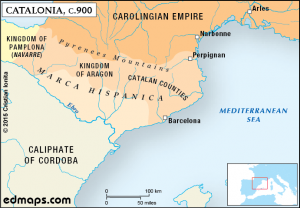15.02.2016 - 06:35
Often described by the Catalan nationalists as a nation without state or a stateless nation, Catalonia is one of the most prosperous regions in Spain. Accepted as a “nationality” by the Spanish state, Catalonia is an autonomous community with its own language, history and symbols, and its own Government and Parliament. Historically, the Catalans have expressed a strong sense of collective identity, which seems to be able to compete with the Spanish national identity. In fact, the genesis and the development of a strong Catalan identity represent a real challenge for a multinational Spanish society ruled by a Castilian-speaking political elite.
If for this elite, Catalonia, as a distinct cultural community, is just a part of a Spain defined as a “nation of nations”, for the Catalans the things are very different. For a vast majority of the Catalans, Catalonia is without doubt a nation. A distinct nation. In this case, as a former Catalan Prime Minister (Pasqual Maragall) suggested, the Spanish state would contain four nations: a Spanish nation, associated to the Castilian-speaking majority, a Galician nation, a Basque nation and, of course, a Catalan nation. Now, the problem is whether the Spanish state provide a suitable framework for dealing with the defense and protection of a Catalan identity in a multinational European Union. For a Catalan nationalist, the question could be even more simple: If, for example, Malta, Luxembourg, Croatia, Estonia, Slovenia and Cyprus can be independent states and full members of the European Union, why not Catalonia? In this context, the independentists’ victory in the September 2015 Catalan regional elections, billed as a de facto referendum on Catalonia’s relationship with the Spanish state, seems to indicate that Catalonia is no more just a “common” nation without state, but a nation in search of its own state…
For a better understanding of this “Catalan question”, let’s put the things on the map…
First of all, let’s note an apparent paradox: “the” Catalonia is not really just the Catalonia associated with the pseudo-referendum on independence… In reality, the September 2015 Catalan elections concerned only the electors from the Autonomous Community of Catalonia. A Catalan community, without doubt, but not “the” Catalan community. According to the Catalan nationalists, the Autonomous Community of Catalonia (often identified as “the Principality” in the nationalist discourse) represents only one of the Catalan lands or countries (Països Catalans). Technically, this term, Països Catalans, refers to the territories where the Catalan language is spoken: Northern Catalonia (France), Andorra, the Autonomous Community of Catalonia (without the Occitan-speaking area of Val d’Aran), the Eastern Aragon (Franja de Ponent), the Eastern part of the Valencian Community, the small region of El Carxe (Murcia), the Balearic Islands and the Italian town of Alghero (Sardinia). In other words, if the project of the Catalonia’s secession is already a nightmare for the Spanish elite, an eventual unification of the Catalan countries would certainly be an apocalyptic scenario for Madrid…  The birth of the Catalan nation is directly associated with the Carolingian Empire and its expansion across the Pyrenees Mountains.
The birth of the Catalan nation is directly associated with the Carolingian Empire and its expansion across the Pyrenees Mountains.
 At the end of the 8th Century, after the expulsion of the Muslims from Narbonne and its hinterland, the Franks, headed by Charlemagne (Emperor of the renewed Roman empire from 800), established a buffer zone between the Iberian Muslims and the Christian territory north of Pyrenees: Marca Hispanica (Spanish March).
At the end of the 8th Century, after the expulsion of the Muslims from Narbonne and its hinterland, the Franks, headed by Charlemagne (Emperor of the renewed Roman empire from 800), established a buffer zone between the Iberian Muslims and the Christian territory north of Pyrenees: Marca Hispanica (Spanish March).
Broadly corresponding to the region between the Pyrenees and the Ebro River, the Spanish March had a diversified population, with a Basque majority in the Western area and a Hispano-Roman one in the Central and the Eastern areas.
After the death of Charlemagne, the March is divided mainly between the kingdoms of Pamplona (Navarre) and Aragon and the Catalan counties (under the hegemony of the County of Barcelona).

